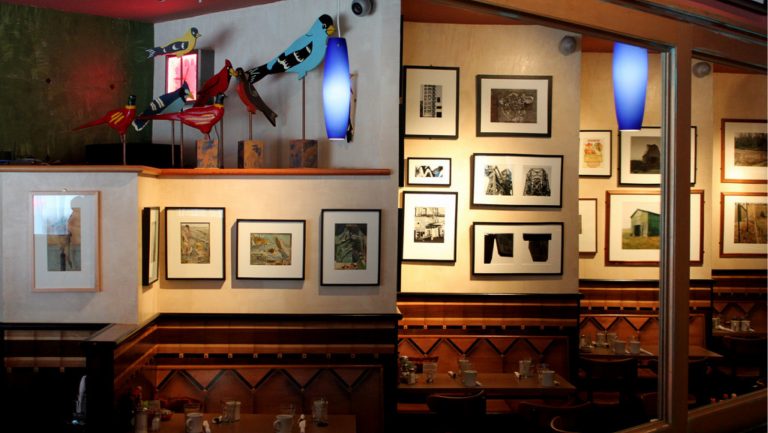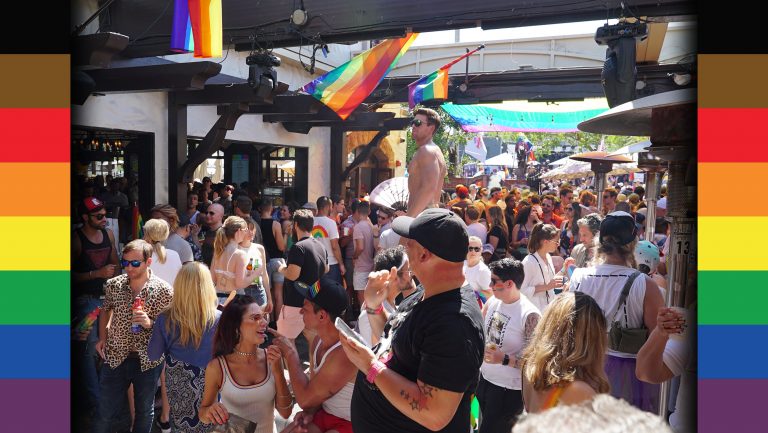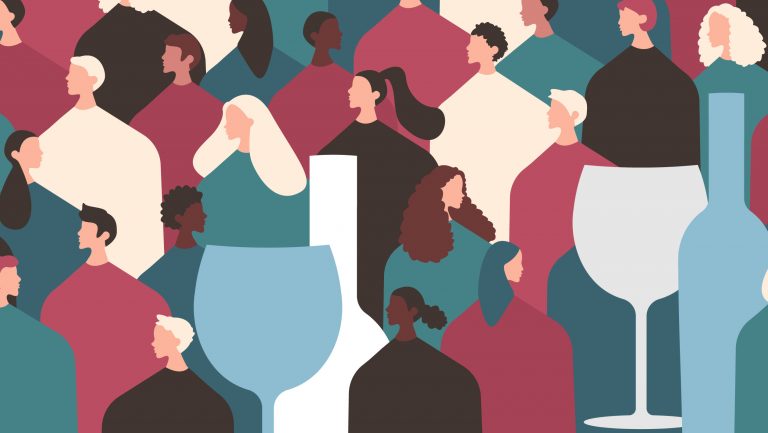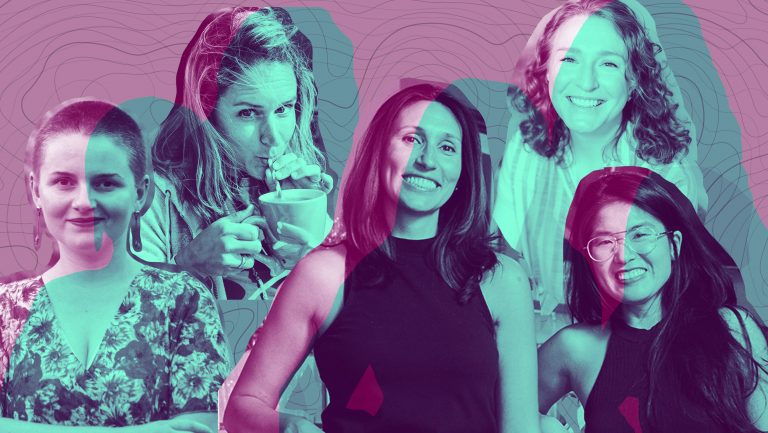On June 12, 2021, members of the activist group Gays Against Guns took over Christopher Street on Sheridan Square in New York City’s West Village. They were dressed in their signature “Human Being” costumes: a ghostlike ensemble of white pants and shirt, white shoes, white hat and veil, and in each of their hands, a large photograph of a gun violence victim. In this case, the portraits were of the 49 people killed five years ago in a mass shooting by a homophobic murderer at the Orlando gay bar, Pulse Nightclub. Gays Against Guns’ event was both a remembrance of those lost to the LGBTQ+ community and a protest in demand of the kind of gun laws that could make all communities safer.
One of many hundreds of protests in the same spot, this demonstration was happening on Sheridan Square because it is the home of The Stonewall Inn. On any given night, The Stonewall is a happy-go-lucky, touristy gay bar. But on certain nights—Pride Sunday, the spectacular Drag March that kicks off Pride Weekend at the end of June, and any time the queer activist community needs to speak out against the brutality and oppression we’ve experienced—The Stonewall is something else. It is the most important symbol in the U.S. of our right to exist.
On June 28, 1969, The Stonewall’s patrons rose up. In resistance to yet another cop raid on a gay bar, they started a riot that lasted three days. This diverse group—which included many Black and brown trans people—created the foundation of the modern gay rights movement. We have them to thank for advances like 2020’s Supreme Court ruling against LGBTQ+ discrimination in the workplace. And it all began at a bar.

Don’t miss the latest drinks industry news and insights. Sign up for our award-winning newsletters and get insider intel, resources, and trends delivered to your inbox every week.
To a 57-year-old lesbian like me, it makes sense. When I came out in the 1980s, gay bars were where I went to meet other women, to make friends and find lovers, to feel like myself. I could flirt, drink, party, and not have to code switch for the comfort of straight people or protect myself from harassment by men. Through the 1990s and the painful height of AIDS, these bars were where lesbians and our gay male pals hung out together after ACT-UP meetings, where we gathered for memorials, where we organized around politics and health care, where we created art and performances. In bars, queer folks made meaning. It had been that way for decades.
“Especially after World War II, the bars were the only place you could reliably find other LGBT people because they were the first place LGBT people could gather legally in public,” says Oberlin College sociologist Greggor Mattson. “Some of the early civil rights cases were about gay people drinking in public and being served alcohol.”
As Dick Leitsch, a leader of the 1960s activist group the Mattachine Society, is known to have said, for the gay community, bars are church. Or, at least, they used to be. You might think that with the emergence of LGBTQ+ rights, the gay bar scene would be stronger than ever. But that’s not the case.
My son, a 22-year-old gay man, is coming of age with far less gay places for him to hang out. Between 2007 and 2019, gay bars declined by more than a third. The 2008 recession, dating apps, and the mainstreaming of a community that can now drink elsewhere have helped to put many gay bars out of business. Places for queers of color saw the steepest decline, losing nearly 60 percent of their numbers. Lesbian bars dropped off by about half. The Lesbian Bar Project, started during COVID to raise awareness for bars’ GoFundMe campaigns, puts that current number of U.S. lesbians bars at 21.
In 2019, we celebrated 50 years of fighting for our rights. Last year, Pride festivities were cancelled nationwide, and COVID-19 threatened many bars. San Francisco icon The Stud shuttered after 54 years. The Stonewall Inn relied on donations to stay afloat. Meanwhile, police raids in the wake of Black Lives Matter protests showed that gay bars are still targeted by cops more than half a century after the Stonewall Riots—particularly when they’re acting as safe spaces for allies from other, overlapping movements.
And, still, as Mattson’s research shows, some gathering spaces are surprisingly resilient. By his count, 16 percent of gay bars closed permanently in COVID’s wake. But that percentage is no more than the decline between 2017 and 2019. Though some of these spaces remain vulnerable as they wait for pre-pandemic crowds to return, says Mattson, “The gay bars that survived the challenging times before the pandemic seem to have weathered the pandemic surprisingly well.”
The relevance of the nation’s remaining gay bars depends on their embrace of the changes that are defining queer life.
Though COVID revealed the creative ways that queers use the Internet to connect when we can’t gather together, it has also emphasized the importance of physical places for building community—particularly in the wake of the Trump era’s social and political upheavals. As President Joe Biden readies to sign into law a Congressional bill declaring Pulse Nightclub a national memorial, the relevance of the nation’s remaining gay bars depends on their embrace of the changes that are defining queer life.
“Gay bars that reestablish themselves as community hubs that embrace all LGBTQ+ people will continue to thrive,” Mattson says. “I think people are hungry to be in the physical presence of others, and there is a brief cohort of people who have turned 21 who haven’t been able to experience bars. It’s on us, the elders, to return and make them the special places of community that must also honor consent, racial justice, and respect for gender identities in order for a bar to justify itself as a community institution for all LGBTQ+ folks.”
This year, as we reemerge into social spaces, there has never been a more important time to celebrate our most lasting gay bars and remember why, with so many other options for queer people nowadays, we should want to save them.
Julius’ Bar, West Village, New York City
The skies had opened up over New York’s West Village, dropping sheets of rain on the narrow streets, but inside Julius’ Bar, the vibe was bright and cozy. Despite the reduced seats at the bar and plexiglass barriers that still separated tables, owner Helen Buford was cheerful. It was a Friday during happy hour early in Pride month, and Governor Andrew Cuomo had just announced that the COVID restrictions on restaurants and bars would lift completely come June 15. The grill man flipped Julius’ famous burgers at his station in the middle of the room as couples toasted to the weekend at two-tops and a big, diverse group of young revelers laughed at a back table.
“People are happy to be back and we’re happy to see them back,” she said. “You hear the laughter, the talking? It just feels like old times.”
It wasn’t just the patrons in the seats that Friday who were happy that Julius’ made it through. During the height of the pandemic, says Buford, “People were emailing from all over the country, from Europe and Australia, saying, ‘Hey, hang in there.’”
That’s because, among gay bars, Julius’ is a legend. Before Stonewall there was the 1966 Sip-In. It took place at Julius’. Bars in those days could have their license revoked for serving gays and Julius’, a corner bar dating from 1867, had gained enough gay clientele by the late 1960s that it was subject to raids. So the stakes were high when the Mattachine Society decided to test the state ban on gay drinkers there. Leitsch and his compatriots ordered cocktails, then declared themselves gay. They were tailed by the press, and when the bartender put his hand over a glass to stop them from drinking, a New York Times photographer captured history. The Sip-In prompted the court case that overturned the state ban and allowed gays to gather in public for drinks.
Today, with its walls of framed photos and newspaper clippings, its National Historic Places designation, and its frequent role as a film location, Julius’ is “like a museum,” as well as a critical gathering space, says Buford. It’s where patrons sought support during the AIDS crisis and gathered in the aftermath of 9/11. Buford’s husband, Eugene, purchased the bar in the late 1990s, and she has been running it since he passed away 11 years ago. “You can’t close it. You don’t want to erase that history, so it disappears and just a little plaque is there,” she says. “People want to experience it.”
With two PPP loans, a low-interest business loan, and a GoFundMe campaign, Buford safeguarded Julius’ legacy through the pandemic shutdown. There were even some silver linings: In coalition with two other restaurants, Julius’ got permission from the city to close down their block of Waverly Place to allow room for patrons to hang out safely, leaving the area blissfully free of traffic. Pride Weekend brought crowds, and Buford managed them with a cover charge and table minimum.
“I have this overwhelming feeling of love. It gets to me in a good way. I want to hug everybody, though I still can’t,” she says. “There’s a sense of joy, family, being there with people you care about. At Julius’, people feel that they’re home. We have to survive just for those reasons alone. You can go to other places, but you can’t be yourself. The LGBT community needs their place to be.”

Alibi Lounge, Harlem, New York City
For nearly five years, Alibi Lounge was New York City’s only Black-owned gay bar. As a pioneer, owner Alexi Minko had a time of it. Twice in 2019, an arsonist, who was subsequently arrested on hate crime charges, set fire to the rainbow flags that flank the entrance to his chic downstairs space. In March 2020, Minko was brutally beaten by strangers inside the bar. Five days later he was forced to close his doors due to COVID-19.
“I was in a state of giving up,” says Minko. “But in the back of my mind, there was still that voice saying, ‘You can’t. You’ll find a way’.” And Minko did. With help from social media–savvy younger patrons, he launched a GoFundMe site that took off, and within days, Alibi Lounge had raised over $100,000. “We received so much support from everyone around the world, it gives us a sense of hope.”
Given the boost, Alibi Lounge was actually one of the businesses able to hire during the pandemic. For an immigrant from Gabon, who came to New York to work as an attorney for the United Nations in 2005, it’s been a journey.
“I spent my first 10 years in the States living downtown where it was easy to go to a gay bar. When I moved to Harlem, I felt more at home with the people, the smells, the colors, the accents.” But despite the neighborhood’s illustrious gay past, with Langston Hughes, Bessie Smith, and other towering gay figures of the Harlem Rennaissance, “I felt the LGBT community was invisible.”
A cozy but lively place with dancers, well-crafted cocktails, and a popular lesbian night, Alibi Lounge brought the Black and gay parts of Minko’s identity together. “The people of Harlem have told me with no qualms that I belong,” he shares. They rallied around Minko when the flags were burned, and when he appeared on the news with an overgrown confinement look, “all my local old ladies on their stoops said, ‘Baby, next time you go on TV, you better cut your hair,’ and I felt like they saw me,” he says. “When I leave the Lounge and go home, I’m neighbors with most of my customers. If I were to buy my bread at the store, I would run into my customers. And that’s really the beauty of it, being a part of the community.”
Despite some continuing hardships—like a July 2020 break-in and robbery, and the ongoing difficulty of finding workers in the wake of the pandemic—Minko banded together with other local entrepreneurs through the small business coalition Harlem Park to Park. The organization built an outdoor lounge space in the street in front of Alibi Lounge. “We put in motion a series of events and measures to make sure we were all helping each other, for example, learn about how to apply for small business loans. It was very beautiful to see people being so unselfish,” says Minko.
With the Black Lives Matter movement opening eyes to racial injustices, gay bars like Alibi Lounge have an important role to play in the queer community and beyond it. “This is a time for society to have a reckoning, and LGBT society has to have its own reckoning,” says Oberlin’s Mattson. “Parts of the community have not been focused on racial justice, but bars that can do this successfully can be a model of the best of our gay bars.”
Minko takes that role seriously. “I hope young LGBT people of color see that it’s possible to become an LGBT business owner if they want to,” he says.
When a second Black-owned gay bar, Lambda Lounge, opened in July 2020, Minko was elated. “Can you imagine that I had to wait five years to not be alone?” he says. “The fact that now there are more of us, it shows the culture of Harlem is shifting. I knew that we’d open the gate to something different. I hope someone opens a gay bakery. Or a gay hair salon. We’re going to see a bigger LGBT presence when it comes to business ownership in Harlem, and that’s the work of Alibi Lounge.”
My Sister’s Room, Atlanta
With lesbian bars on the wane, “the sense of loss is real,” says Gwen Shockey, an artist who created an interactive map of 200-plus women’s spaces in New York City from 1911 forward. Nearly all are gone. There are just three lesbian bars left in the metropolis, and one of them—Ginger’s in Brooklyn—has yet to reopen following its pandemic closure.
Rent hikes in gentrifying urban areas make business ownership difficult “if you’re not a white cis-gendered male,” says Shockey. “But the hope is that, with people’s identities becoming more fluid, maybe we need different types of spaces. Someone who is non-binary doesn’t necessarily feel comfortable in a lesbian bar. You have to be inclusive to keep a space open.
One lesbian-owned space that fits that model is My Sister’s Room, a 25-year-old bar, club, and restaurant in Atlanta, Georgia. When they bought it in 2011, Jami Atlanta and Jen-Chase Daniels told themselves, “Let’s see if we can revamp it. Let’s make it a no-label zone.”
First the couple diversified their staff. Then they introduced more varied programming. “Music, drag, comedy, burlesque, karaoke—we’re diverse in age, race, guys, girls,” says Daniels.
Patrons travel from all over Georgia to experience My Sister’s Room, reports Atlanta. “People come from these small towns where they didn’t know any trans people. They had ideas in their head, and they come here and say, ‘Hey, that’s really cool.’” Rural gays also can let their hair down. “A guy will say, ‘I can’t wear makeup out.’ A girl will say, ‘I can’t kiss my girlfriend out.’ Their minds are blown that they can be themselves.”
The pandemic proved “catastrophic” financially, and the couple has had to “wear many different hats,” says Daniels, as they wait for the pool of potential hires to be replenished. Because vaccination rates are lower in the small towns where many bar patrons live, the owners are requiring guests to show their vaccination card at the door.
But COVID has brought improvements, too. The duo converted half the employee parking lot into a new outdoor lounge, and they’ve “stepped up their game” on sanitation.
“We used to have the bar cleaned professionally once a week. Now the staff does that work every day, making it as safe as possible so everyone feels welcome,” says Daniels. After all, that’s the mission of My Sister’s Room. “It’s meant to be a space that’s for everyone.”

The Abbey, Los Angeles
Leave it to Hollywood to give its most famed gay bar a reality show. In the single season of the 2017 E! network show “What Happens at The Abbey,” viewers watched the hot, young staff of this church-themed destination bar hook up, break up, and everything in between. While entertaining, it was also, according to owner David Cooley, an important vehicle for LGBTQ+ visibility. “Even in modern pop culture, it’s not that common for a gay bar to be featured on television,” he says.
If there’s a Los Angeles equivalent to The Stonewall Inn, a place where gay West Hollywood gravitates in times of celebration and in times of pain, it’s The Abbey. This sprawling, indoor-outdoor restaurant and club is “an unofficial town hall,” describes Cooley who opened the bar as a quiet corner coffee shop 29 years ago when there were very few gay establishments.
In the years since, a gay-centric neighborhood dubbed Boys Town has grown up around it, and The Abbey, says Cooley, “has used its voice and provided space to support our local community, our national community, and people and policies that help advance LGBTQ rights.” It’s hosted fundraisers for gay-friendly politicians including Hillary Clinton, Kamala Harris, Pete Buttegieg, and Barbara Boxer, and for gay rights organizations like the national Human Rights Campaign and local LGBTQ+ sports teams.
Cooley has used The Abbey as a platform for activism through nearly three decades of milestones. “We took a stance in 2012 when we banned bachelorette parties during our fight for marriage equality, we hosted free weddings for LGBTQ+ couples when marriage equality was achieved, we honored the 50th anniversary of the Stonewall Riots as an ambassador for Stonewall’s Pride Live organization, and we marched in solidarity with Pulse Nightclub in 2016 on the day of this country’s worst massacre in LGBTQ history.”
All the while, he’s been keeping the celebrity-peppered crowds coming by polishing The Abbey’s gloss, including a 2015 expansion to an adjacent space called The Chapel and the 2019 launch of a bar inside a bar, called Within.
The Abbey’s evolution is a testament to independent ownership. Though Mattson conjectures that some gay bars might be saved by corporate ownership, The Abbey shows things to be more complicated. In 2007, when Cooley sold out to nightclub group SBE, regulars complained that the corporation ruined it by implementing tough security and pricey bottle service. The Abbey was still gay, but it was no longer “church.”
Cooley bought it back in 2015, and The Abbey returned to its community-oriented ways. “Our bars are where LGBTQ people are free to express who they are, find love and build friendships, experience gay culture and learn ways to get involved in activism to advance gay rights,” he says.
COVID brought four closures to The Abbey in 15 months, some longer than 30 days, as Los Angeles’ infection rates spiraled out of control. Leading up to 12:01 AM on June 15 of this year, when the city finally did away with pandemic restrictions after mass vaccinations, Cooley held a countdown party, and the community turned out. “We saw our dance floor energized with people who were happy to dance and return to life as we knew it before COVID,” he says. “We are not at the end of the pandemic yet, but we are happy to see our customers finally able to order drinks at the bar again. We consider ourselves to be in the new Roaring 20s!”
The Abbey turns 30 this year, and the pandemic’s waning comes just in time for the bar’s star-studded celebrations. “We officially moved into Pride Month with an anniversary party on May 23 with a huge surprise visit by Lady Gaga and the city of West Hollywood declaring that day both ‘Born This Way Day’ and ‘The Abbey Day,’” boasts Cooley. “Going forward we’ll be celebrating Pride every day we can, including West Hollywood’s first official WeHo Pride at the end of June.”
With the nearby greenspace West Hollywood Park opening in autumn and the sprawling retail and entertainment complex Robertson Lane set for groundbreaking across the street, Cooley’s bar will continue in its role as historic anchor to a burgeoning area.
“Gay bars are more than just safe spaces for LGBTQ to socialize,” he says. “They’re neighborhood institutions with their own personalities and unique history.”

Big Chick’s, Chicago
It’s been 34 years since Michelle Fire rehabbed an uptown dive, filled it with art by the likes of Diane Arbus, and opened a gay bar called Big Chick’s. How has she managed to spend half her life running this local institution?
“Our ability to last is [about] not being stuck in a moment. We have changed,” she says. Guys who came to cruise in their 20s now come for a meal. “Gay bars have changed their function. We metamorphosed with food and a beautiful wine program that took off.”
After so many years of slow evolution, Big Chick’s saw rapid-fire changes under COVID: closing then reopening for to-go service, and then reconfiguring the dining room for safely spaced indoor seating, and removing the popular dance floor. Now that restrictions have eased again, staffing and supply chains are slower to recover.
But living through the AIDS crisis taught Fire fortitude, and perspective. “I’ve been working in gay bars since 1979. I’ve seen a lot of lack of concern, a lot acting as if nothing’s going on. That’s not going to happen here,” she says. “Back then, you loved someone, saw them every day for cocktails, then they told you they were sick and disappeared. It’s not like that for us [during this pandemic]. It’s less visceral, less connected, more abstract. AIDS was right next to me crying on my shoulder.”
Fire calls herself a “cautious person,” and the experience she gained living through the worst of the AIDS years has helped her keep her own counsel. For now, she’s keeping Big Chick’s “very convivial, not intense” by retaining reduced hours and holding off on the dance floor, even as competitor bars across Chicago are “butt-to-belly crowding people in.”
“Before I declare victory over a pandemic and get back to 100 percent, I’m going to put my toe in the water,” she says. “The pathogen threatens a real community. I can’t control the world. All I can control is my space.”
Patrons who visit Big Chick’s might be disappointed to find that some pre-pandemic Big Chick’s staples are no more. “I am not going to do the free Sunday buffet or buck burger Monday, which actually cost me $2.50 a plate. I did do it for 34 years, so I hope you enjoyed it for those 34 years,” says Fire.
But that won’t kill her bar’s Cheers-like charm. “At Big Chick’s almost everybody knows everybody. It’s a very neighborly, accepting outpost.” It delivers the most important thing that a gay bar can: “It’s the human connection that everybody needs. We’ve always been able to provide that, and we still can.”
Editor’s note: This is an updated version of an article we originally published on June 29, 2020

Dispatch
Sign up for our award-winning newsletter
Don’t miss the latest drinks industry news and insights—delivered to your inbox every week.
Betsy Andrews is an award-winning journalist and poet. Her latest book is Crowded. Her writing can be found at betsyandrews.contently.com.








